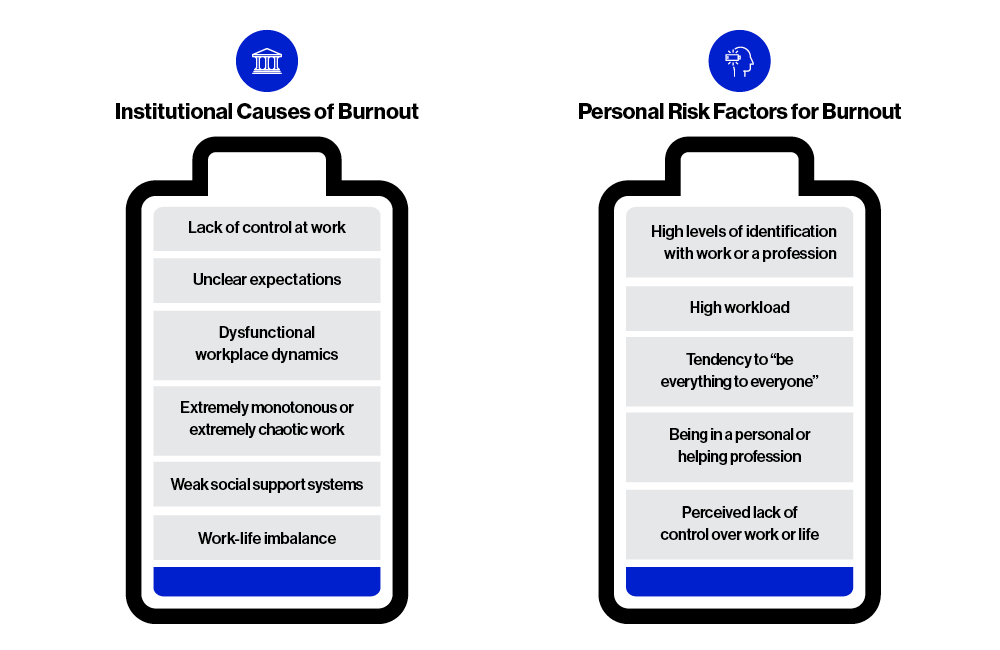Employee Burnout Is a Risk Management Issue
Faculty and staff in K-12 and higher education are reporting crisis-level feelings of burnout. Working around the clock to deliver the best education possible amid staffing and budget cuts and juggling at-home responsibilities exacerbates burnout to a point where large numbers of employees may be suffering.
A 2022 Gallup survey found that “K-12 workers have the highest burnout rate” of any industry in the United States, with 52% of K-12 teachers reporting they are “very often” or “always” burned out. In higher education, a 2020 Chronicle of Higher Education survey showed more than two-thirds feel burned out.
In addition to burnout’s human resource challenges like increased turnover and reduced productivity, burnout creates conditions where all types of risk — including liability risk — can flourish. A strong focus on workplace practices and employee well-being can limit the impact of burnout on liability risk and even improve campus culture.
What Is Burnout?
The World Health Organization (WHO) defines burnout as “a syndrome conceptualized as resulting from chronic workplace stress that has not been successfully managed.” The WHO specifies that burnout has three dimensions:
- Feelings of energy depletion or exhaustion
- Increased mental distance from one’s job, or feelings of negativism or cynicism related to one's job
- Reduced professional efficacy
Burnout may coincide with or aggravate mental health conditions such as anxiety, depression, or substance abuse, but it is not a mental health condition and can be experienced independent of them. At-home caretaking responsibilities also can contribute to burnout, as many people learned during the pandemic.

The Mayo Clinic elaborates on causes and risk factors for burnout. The decentralization of many K-12 schools, colleges, and universities combined with the emotional nature of educational work can leave your colleagues more exposed to burnout than people are in other professions.
In addition to the personal impact of burnout, it shows up at the workplace in subtle ways through fatigue, conflict-seeking behavior, inattention to detail, distraction, alienation from colleagues, increased risk taking, poor data recording practices, and avoiding administrative processes — all of which could lie at the root of a liability claim.
Liability Risks of Employee Burnout
Most research on burnout in K-12 schools, colleges, and universities investigates the impact of teacher and professor burnout on student success. Unsurprisingly, studies find that students of burned-out teachers and professors have worse academic outcomes than their peers. In K-12 schools, students with burned-out teachers are more likely to misbehave — or their teachers may be more likely to discipline.
Research on the impact of burnout in education and other industries shows common behaviors of burned-out employees, whether teachers, physicians, police officers, or administrators. Many of those behaviors are root causes to incidents involving liability risk. For example:
- Increased aggressiveness can lead campus safety officers to use unnecessary force and faculty to create a belligerent and hostile work environment for their colleagues.
- Inattention to detail can lead employees to overlook indemnification in contracts, forget critical safety protocols, or exercise poor judgment while driving.
- Reduced empathy and trust can lead teachers, faculty, and administrators to miss indications that a student is struggling with physical or mental health — or worse, exacerbate the ailment or disability.
- Increased entitlement can lead employees to commit fraud or intentionally ignore compliance policies.
The impact of burnout on liability is not just theoretical: Burned out physicians have been shown to be 1.5 times likelier to be involved in a vehicle crash than their non-burned-out colleagues.
Tips for Managing Burnout
There are many potential causes for burnout. Your institution can’t control all of them, but there are steps you can take to mitigate the feeling of burnout among faculty and staff.
Implement and Promote Wellness Programs
- Measure burnout. Consider whether to survey employees to identify the impact and causes of burnout, as well as some potential solutions.
- Implement wellness and stress management programs. Assess these programs to see whether they address burnout and consider implementing services like child care centers that help employees balance work and non-work pressures.
- Focus on diversity, equity, and inclusion (DEI). Identify ways your DEI programs can address the unique causes of burnout among underrepresented groups. If your institution doesn’t have a program, consider launching one with burnout mitigation as one of its goals.
- Take a holistic approach. Include burnout among the risks your enterprise risk management program assesses, mitigates, and monitors.
Revisit Workplace Practices and Priorities
- Remember to say “Thank you.” Small gestures such as recognition of hard work or a gift to employees can develop a sense of shared purpose and build social support structures, countering two systemic causes of burnout.
- Revisit roles. Compare position descriptions to the amount and nature of work done to give employees reasonable productivity targets and the flexibility needed to meet those goals.
- Reset priorities. To allow employees to focus on projects with the most impact, consider which projects and tasks to prioritize and which other tasks are secondary.
- Balance the rewarding and mundane. Although most jobs have unappealing tasks, seek opportunities for employees to do work they find meaningful throughout the week.
- Optimize administrative systems. Find opportunities to streamline administrative tasks that employees find monotonous or draining.
More From UE
Diversity, Equity, and Inclusion Course Collection
Additional Resources
Mayo Clinic: Job Burnout – How to Spot It and Take Action
Harvard Business Review: Employee Burnout Is a Problem with the Company, Not the Person
About the Author
-

Justin Kollinger
Senior Risk Management Consultant
Justin advises UE members as they develop risk mitigation tactics, prioritize risk management goals, and launch or refresh enterprise risk management (ERM) initiatives. He leads the Risk Management Premium Credit (RMPC) program and co-authored Risk Management: An Accountability Guide for University and College Boards. Prior to joining UE, Justin consulted with community college presidents and K-12 heads of school on strategic revenue challenges and worked in admissions at two private colleges in the Mid-Atlantic.





